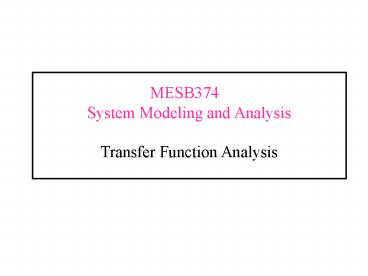ME375 Dynamic System Modeling and Control PowerPoint PPT Presentation
1 / 18
Title: ME375 Dynamic System Modeling and Control
1
MESB374 System Modeling and AnalysisTransfer
Function Analysis
2
Transfer Function Analysis
- Dynamic Response of Linear Time-Invariant (LTI)
Systems - Free (or Natural) Responses
- Forced Responses
- Transfer Function for Forced Response Analysis
- Poles
- Zeros
- General Form of Free Response
- Effect of Pole Locations
- Effect of Initial Conditions (ICs)
- Obtain I/O Model based on Transfer Function
Concept
3
Dynamic Responses of LTI Systems
- Ex Lets look at a stable first order
system
- Take LT of the I/O model and remember to keep
tracks of the ICs
- Rearrange terms s.t. the output Y(s) terms are on
one side and the input U(s) and IC terms are on
the other
- Solve for the output
Free Response
Forced Response
4
Free Forced Responses
- Free Response (u(t) 0 nonzero ICs)
- The response of a system to zero input and
nonzero initial conditions. - Can be obtained by
- Let u(t) 0 and use LT and ILT to solve for the
free response. - Forced Response (zero ICs nonzero u(t))
- The response of a system to nonzero input and
zero initial conditions. - Can be obtained by
- Assume zero ICs and use LT and ILT to solve for
the forced response (replace differentiation with
s in the I/O ODE model).
5
In Class Exercise
- Find the free and forced responses of the car
suspension system without tire model
- Take LT of the I/O model and remember to keep
tracks of the ICs
- Rearrange terms s.t. the output Y(s) terms are on
one side and the input U(s) and IC terms are on
the other
- Solve for the output
Free Response
Forced Response
6
Forced Response Transfer Function
- Given a general n-th order system model
- The forced response (zero ICs) of the system due
to input u(t) is - Taking the LT of the ODE
Forced Response
Transfer Function
Inputs
Inputs
Transfer Function
7
Transfer Function
- Given a general nth order system
- The transfer function of the system is
- The transfer function can be interpreted as
u(t) Input
y(t) Output
U(s) Input
Y(s) Output
Differential Equation
G(s)
Time Domain
s - Domain
8
Transfer Function Matrix
- For Multiple-Input-Multiple-Output (MIMO) System
with m inputs and p outputs
Inputs
Outputs
9
Poles and Zeros
Given a transfer function (TF) of a system
- Poles
- The roots of the denominator of the TF, i.e. the
roots of the characteristic equation.
n poles of TF
10
Examples
- (1) Recall the first order system
- Find TF and poles/zeros of the system.
- (2) For car suspension system
- Find TF and poles/zeros of the system.
- Pole
- Pole
- Zero
- Zero
- No Zero
11
System Connections
- Cascaded System
Output
Input
Parallel System
Feedback System
-
Output
Input
12
General Form of Free Response
- Given a general nth order system model
- The free response (zero input) of the system due
to ICs is - Taking the LT of the model with zero input
- (i.e.,
)
A Polynominal of s that depends on ICs
Free Response (Natural Response)
Same Denominator as TF G(s)
13
Free Response (Examples)
- Ex Find the free response of the car suspension
system without tire model (slinker toy) - Ex Perform partial fraction expansion (PFE) of
the above free response when -
(what does this set of ICs means physically)?
phase initial conditions
Decaying rate damping, mass
Frequency damping, spring, mass
Q Is the solution consistent with your physical
intuition?
14
Free Response and Pole Locations
- The free response of a system can be represented
by
exponential decrease
constant
exponential increase
decaying oscillation
Oscillation with constant magnitude
increasing oscillation
t
15
Complete Response
Y(s) Output
U(s) Input
- Complete Response
- Q Which part of the system affects both the free
and forced response ? - Q When will free response converges to zero for
all non-zero I.C.s ?
Denominator D(s)
All the poles have negative real parts.
16
Obtaining I/O Model Using TF Concept (Laplace
Transformation Method)
- Noting the one-one correspondence between the
transfer function and the I/O model of a system,
one idea to obtain I/O model is to - Use LT to transform all time-domain differential
equations into s-domain algebraic equations
assuming zero ICs (why?) - Solve for output in terms of inputs in s-domain
to obtain TFs (algebraic manipulations) - Write down the I/O model based on the TFs obtained
17
Example Car Suspension System
- Step 1 LT of differential equations assuming
zero ICs
- Step 2 Solve for output using algebraic
elimination method
- of unknown variables equations ?
2. Eliminate intermediate variables one by one.
To eliminate one intermediate variable, solve for
the variable from one of the equations and
substitute it into ALL the rest of equations
make sure that the variable is completely
eliminated from the remaining equations
18
Example (Cont.)
from first equation
Substitute it into the second equation
- Step 3 write down I/O model from TFs

